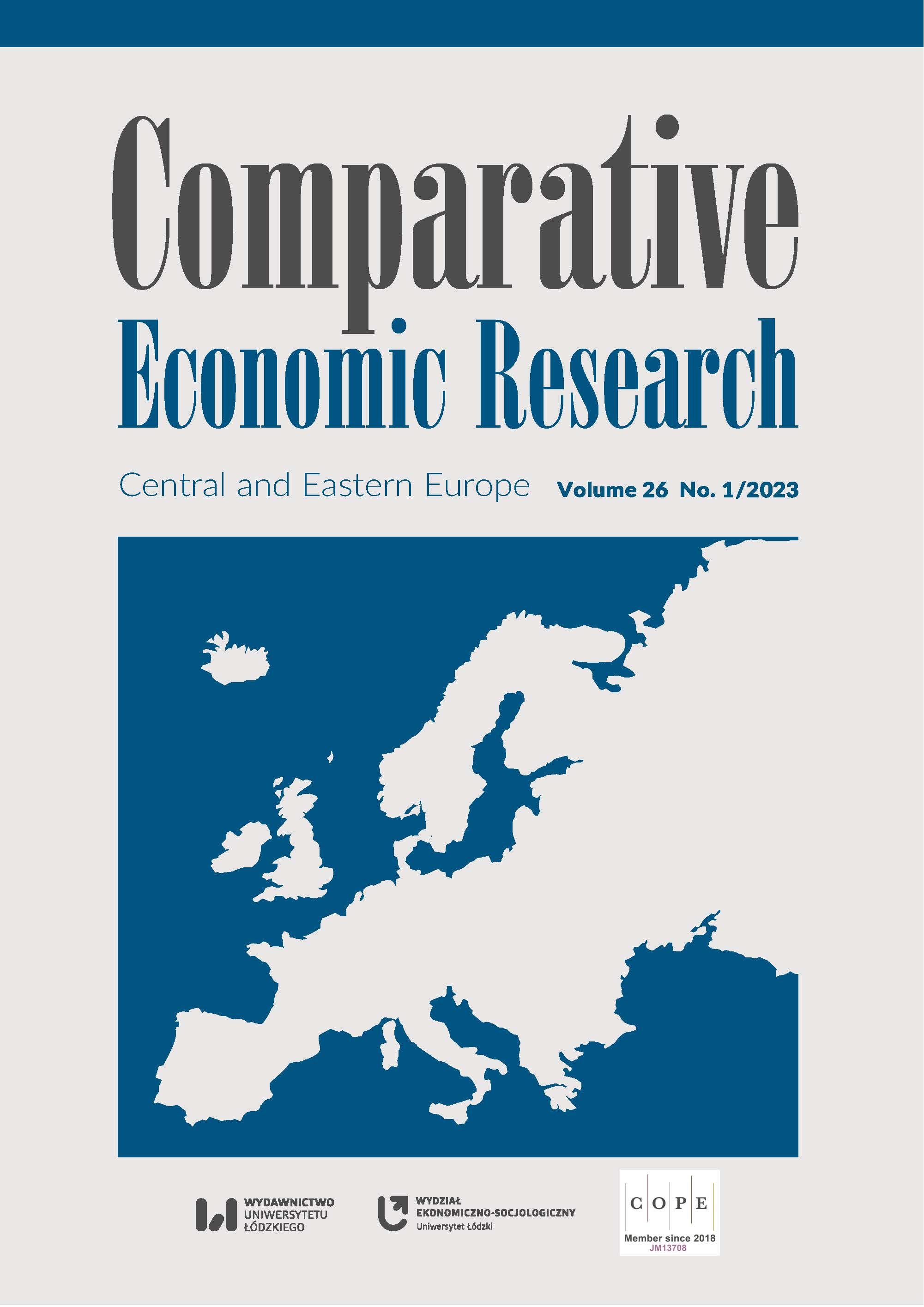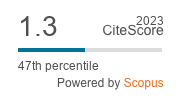Mortality and Health Spending during the First Year of the COVID–19 Pandemic. Comparing Central, Eastern and Western Europe
DOI:
https://doi.org/10.18778/1508-2008.26.04Keywords:
COVID mortality, Stringency Index, non‑COVID mortality, Johansen test, cointegration, healthcare spendingAbstract
The article shows the relationships between the COVID and non‑COVID deaths during the first year of the pandemic, compared with the stringency of restrictions imposed and the compulsory spending on healthcare. We compare these relationships among European countries, analysing weekly data and applying cointegration models. Regarding the pandemic’s intensity, we split the period into two: March – August 2020 and September 2020 – February 2021. We find that, most often, if there was a relationship between the stringency index and COVID or non‑COVID mortality, it was usually positive and mortality driven. That suggests that although the governments tailored the restrictions to the growing mortality rate, they were unable to control the pandemic. No relationships, or negative ones, were most often found in these countries where the spending on healthcare was the highest (i.e., Northern and Western European countries). The biggest weekly changes in non‑COVID deaths during the second sub‑period were observed in the Central and Eastern European countries, where government healthcare expenditures per capita are the lowest.
Downloads
References
Arendt, F., Markiewitz, A., Mestas, M., Scherr, S. (2020), COVID–19 pandemic, government responses, and public mental health: Investigating consequences through crisis hotline calls in two countries, “Social Science Medicine”, 265, 113532, https://doi.org/10.1016/j.socscimed.2020.113532
Google Scholar
DOI: https://doi.org/10.1016/j.socscimed.2020.113532
Blondel, S., Vranceanu, R. (2020), COVID–19 Mortality and Health Expenditures across eEuropean Countries: The Positive Correlation Puzzle, https://doi.org/10.2139/ssrn.3679972
Google Scholar
DOI: https://doi.org/10.2139/ssrn.3679972
Chudik, A., Mohaddes, K., Pesaran, M.H., Raissi, M., Rebucci, A. (2020), Economic consequences of COVID–19: A counterfactual multi‑country analysis, “NBER Working Paper Series”, 27855, National Bureau of Economic Research, Cambridge, https://doi.org/10.3386/w27855
Google Scholar
DOI: https://doi.org/10.3386/w27855
Davillas, A., Jones, A.M. (2021), Unmet health care need and income‑related horizontal equity in use of health care during the COVID–19 pandemic, “Health Economics”, 30 (7), pp. 1711–1716, https://doi.org/10.1002/hec.4282
Google Scholar
DOI: https://doi.org/10.1002/hec.4282
Elola‑Somoza, F., Bas‑Villalobos, M., Pérez‑Villacastín, J., Macaya‑Miguel, C. (2021), Public healthcare expenditure and COVID–19 mortality in Spain and in Europe, “Revista Clínica Española (English Edition)”, 221 (7), pp. 400–403, https://doi.org/10.1016/j.rceng.2021.09.001
Google Scholar
DOI: https://doi.org/10.1016/j.rceng.2020.11.006
Engle, R.F., Granger, C.W. (1987), Co‑Integration and Error Correction: Representation, Estimation, and Testing, “Econometrica: Journal of the Econometric Society”, 55 (2), pp. 251–276, https://doi.org/10.2307/1913236
Google Scholar
DOI: https://doi.org/10.2307/1913236
Eurostat (2021a), COVID–19. Data, https://ec.europa.eu/eurostat/web/covid-19/data (accessed: 18.05.2022).
Google Scholar
Eurostat (2021b), Deaths by week – special data collection, https://ec.europa.eu/eurostat/web/population-demography/demography-0population-stock-balance/database?node_code=demomwk (accessed: 21.04.2021).
Google Scholar
Fuller, J.A., Hakim, A., Victory, K.R., Date, K., Lynch, M., Dahl, B., Henao, O., CDC COVID–19 Response Team (2021), Mitigation Policies and COVID–19‑Associated Mortality–37 European Countries, January 23–June 30, 2020, “Morbidity and Mortality Weekly Report”, 70 (2), pp. 58–62, https://doi.org/10.15585/mmwr.mm7002e4
Google Scholar
DOI: https://doi.org/10.15585/mmwr.mm7002e4
Hale, T., Angrist, N., Goldszmidt, R., Kira, B., Petherick, A., Phillips, T., Webster, S., Cameron‑Blake, E., Hallas, L., Majumdar, S., Tatlow H. (2021), A global panel database of pandemic policies (Oxford COVID–19 Government Response Tracker), “Nature Human Behaviour”, 5, pp. 529–538, https://doi.org/10.1038/s41562-021-01079-8
Google Scholar
DOI: https://doi.org/10.1038/s41562-021-01079-8
Hassler, U., Wolters, J. (1994), On the power of unit root tests against fractional alternatives, “Economics Letters”, 45 (1), pp. 1–5, https://doi.org/10.1016/0165-1765(94)90049-3
Google Scholar
DOI: https://doi.org/10.1016/0165-1765(94)90049-3
Johansen, S. (1991), Estimation and Hypothesis Testing of Cointegration Vectors in Gaussian Vector Autoregressive Models, “Econometrica”, 59 (6), pp. 1551–1580, https://doi.org/10.2307/2938278
Google Scholar
DOI: https://doi.org/10.2307/2938278
Kontopantelis, E., Mamas, M.A., Deanfield, J., Asaria, M., Doran, T. (2021), Excess mortality in England and Wales during the first wave of the COVID–19 pandemic, “Journal of Epidemiology & Community Health”, 75 (3), pp. 213–223, http://doi.org/10.1136/jech-2020-214764
Google Scholar
DOI: https://doi.org/10.1101/2020.05.26.20113357
Le, K., Nguyen, M. (2021), The psychological burden of the COVID–19 pandemic severity, “Economics Human Biology”, 41, 100979, https://doi.org/10.1016/j.ehb.2021.100979
Google Scholar
DOI: https://doi.org/10.1016/j.ehb.2021.100979
Lee, D., Schmidt, P. (1996), On the power of the KSPP test of stationarity against fractionally‑integrated alternatives, “Journal of Econometrics”, 73 (1), pp. 285–302, https://doi.org/10.1016/0304-4076(95)01741-0
Google Scholar
DOI: https://doi.org/10.1016/0304-4076(95)01741-0
Mckibbin, W., Fernando, R. (2020), The Global Macroeconomic Impacts of COVID–19: Seven Scenarios, “CAMA Working Paper”, 19, https://doi.org/10.2139/ssrn.3547729
Google Scholar
DOI: https://doi.org/10.2139/ssrn.3547729
OECD (2022), Health spending, https://doi.org/10.1787/8643de7e-en
Google Scholar
DOI: https://doi.org/10.1787/8643de7e-en
Pfaff, B. (2008), Analysis of Integrated and Cointegrated Time Series with R, Springer, New York, https://doi.org/10.1007/978-0-387-75967-8
Google Scholar
DOI: https://doi.org/10.1007/978-0-387-75967-8
Saladino, V., Algeri, D., Auriemma, V. (2020), The Pychological and Social Impact of COVID–19: New Perspectives of Well‑Being, “Frontiers in Psychology”, 11, pp. 1–6, https://doi.org/10.3389/fpsyg.2020.577684
Google Scholar
DOI: https://doi.org/10.3389/fpsyg.2020.577684
Sciensano (2021), Analyse van de oversterfte gelinkt aan COVID–19 in 2020, https://www.sciensano.be/nl/pershoek/analyse‑van‑de‑oversterfte‑gelinkt‑aan‑covid-19-2020 (accessed: 1.06.2021).
Google Scholar
Sornette, D., Mearns, E., Schatz, M., Wu, K., Darcet, D. (2020), Interpreting, Analysing and Modelling COVID–19 Mortality Data, “Swiss Finance Institute Research Paper”, 20–27, http://doi.org/10.2139/ssrn.3586411
Google Scholar
DOI: https://doi.org/10.2139/ssrn.3586411
Stein, L. (2020), Belgium appears to have the highest coronavirus mortality rate in the world. Here’s why, https://www.abc.net.au/news/2020-05-18/why‑belgium‑has‑a‑high‑number‑of‑coronavirus‑deaths/12259032 (accessed: 18.05.2022).
Google Scholar
Stukalo, N., Simakhova, A., Baltgailis, J. (2022), The COVID–19 Pandemic’s Impact on the Social Economy in European Countries, “Comparative Economic Research. Central and Eastern Europe”, 25 (1), pp. 109–125, https://doi.org/10.18778/1508-2008.25.07
Google Scholar
DOI: https://doi.org/10.18778/1508-2008.25.07
The COVID Tracking Project (2021), https://github.com/COVID19Tracking (accessed: 18.05.2022).
Google Scholar
Walker, P.G.T., Whittaker, C., Watson, O.J., Baguelin, M., Winskill, P., Hamlet, A., Djafaara, B.A., Cucunubá, Z., Olivera Mesa, D., Green, W., Thompson, H., Nayagam, S., Ainslie, K.E.C., Bhatia, S., Bhatt, S., Boonyasiri, A., Boyd, O., Brazeau, N.F., Cattarino, L., Cuomo‑Dannenburg, G., Dighe, A., Donnelly, C.A., Dorigatti, I., Elsland, S.L. van, FitzJohn, R., Fu, H., Gaythorpe, K.A.M., Geidelberg, L., Grassly, N., Haw, D., Hayes, S., Hinsley, W., Imai, N., Jorgensen, D., Knock, E., Laydon, D., Mishra, S., Nedjati‑Gilani, G., Okell, L.C., Unwin, H.J., Verity, R., Vollmer, M., Walters, C.E., Wang, H., Wang, Y., Xi, X., Lalloo, D.G., Ferguson, N.M., Ghani, A.C. (2020), The impact of covid–19 and strategies for mitigation and suppression in low‑ and middle‑income countries, “Science”, 369 (6502), pp. 413–442, https://doi.org/10.1126/science.abc0035
Google Scholar
DOI: https://doi.org/10.1126/science.abc0035
Downloads
Published
How to Cite
Issue
Section
License

This work is licensed under a Creative Commons Attribution-NonCommercial-NoDerivatives 4.0 International License.











